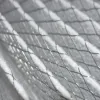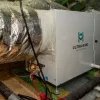Here in the American South, summers are really hot and humid. In theory, air conditioners should help you deal with both of those things. But in practice, many air conditioners are ok at lowering the temperature but not so great at reducing humidity. What gives?
If you're wondering how to lower humidity in your house, you're not alone.
From spring through fall, we field lots of calls from homeowners who are frustrated with high indoor humidity. The good news is that there's always a solution to this problem — and it can be a permanent one.
However, every home is different! What works best for lowering the humidity in your neighbor's house isn't necessarily going to be the best solution for your house. That's why we always go through the following steps when determining the best way to manage indoor humidity.
1. Perform a home assessment and heating & air system inspection
Does your home have big air leaks that let in a lot of humidity? Is your AC oversized for your house? Are problems with your ductwork preventing the AC from working properly?
All of these are possible reasons for the uncomfortable humidity level in your house. Our home assessment and HVAC inspection uncover these issues via:
- A blower door test and thermal imaging analysis that shows where humid air infiltrates your home from the outdoors
- AC checkup to see whether your fan speed is set properly to cool and remove humidity
- Manual J load calculation to determine whether the existing air conditioner is the right size for your home; we don't always do this as part of a home assessment, but it's a good idea if you think (and if our team has a hunch) that your air conditioner is oversized.
- Visual inspection of the ductwork to see if the system isn't moving air effectively throughout the home
It's important to go through all of these steps before attempting to change anything about your home or your air conditioning system. Otherwise, you might end up focusing on the wrong issue and not solving your humidity problem!
For example, consider a homeowner who replaces an old air conditioner in an attempt to lower humidity. He might find that the new unit doesn't change anything. Had he learned that large amounts of air infiltration from his crawlspace was the real source of the humidity problem before making that big purchase, he might have paid for a simple air-sealing service instead.
Oh, and he would have solved the problem. That, too.
2. Perform HVAC adjustments and/or home performance improvements
The specifics of this step follow from the results of the first step. Here are some examples of things that might lower your home's humidity, depending on the source of the problem:
- Adjusting your AC and ductwork to improve humidity management; this could involves changing the fan speed, replacing damaged or improperly sized ducts, or other modest adjustments.
- Sealing large air leaks, which are typically located around ducts, pipes, and electrical penetrations between your living space and your crawlspace or attic
- Replacing an older AC; this may be the best option if your current AC is pretty old (over 12 years old is what we'd consider "old") and that older AC is the wrong size for your home
To expand a bit on that third bullet point, it's very common in our area for contractors and builders to install air conditioners that are too large for the homes they're tasked with cooling. Installers do this because they're afraid of installing an AC that's too small to cool the home. What they fail to realize is that an oversized unit will cool the home too quickly and fail to remove enough humidity!
That's because the longer an AC runs, the more humidity it removes. An oversized system will satisfy your thermostat setting quickly. But it won't run for long enough to remove very much moisture.
So, when you have an older AC that wasn't the right size for your home, to begin with, replacing it is often a good idea. The longer run times of a properly sized unit will go a long way toward lowering the humidity in your house!
3. Install a whole-house dehumidifier
What if the best solution is to replace your AC, but you're not ready to do that?
Or what if high humidity bothers you during the spring and fall "shoulder" seasons when you aren't running your AC? What then?
Or maybe making the adjustments described above did lower your house's humidity, but you want it even lower. What then?
Well, you can install a whole-house dehumidifier! These units connect to your HVAC system and remove humidity to a preset threshold. When given the option to set specific humidity levels in their homes, most people prefer 50% to 55% relative humidity (RH). With a dehumidifier, you can set the RH on your thermostat and let the system do its thing. Problem solved!
The dehumidifier will pick up the slack for your AC. When the AC finishes a cooling cycle and there's still too much humidity in the air, the dehumidifier turns on and removes the excess moisture. Even in homes with properly sized air conditioners, good air sealing, and a well-designed duct system, dehumidifiers are helpful because you can use them even when you're not using the AC.
This is great in, say, early May. It's not hot enough for the AC yet, but the air is still uncomfortably humid. The dehumidifier takes care of the problem, and you can leave the air conditioner off!
Still struggling to lower humidity in the house? We can help with that.
While every home requires a unique fix, the procedures and solutions described above are the best way to lower humidity in your house.
If you live in Metro Atlanta and have a humidity issue, give us a call or connect with us online! We'll visit your home and perform the necessary steps to determine the best way to lower your humidity and help you stay comfortable!






